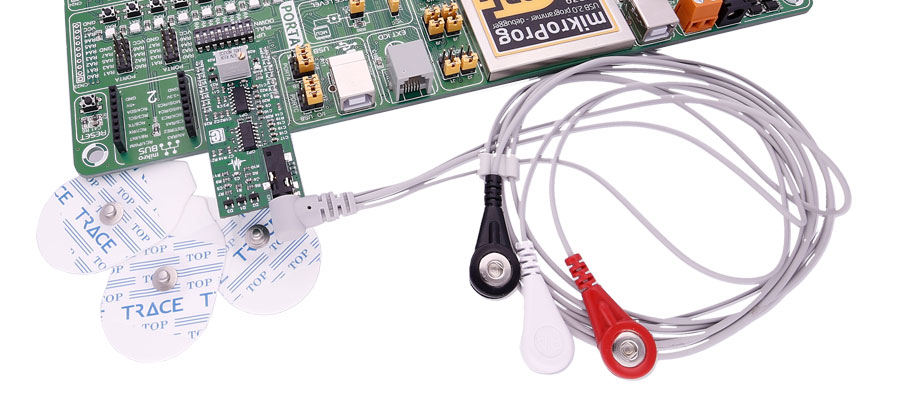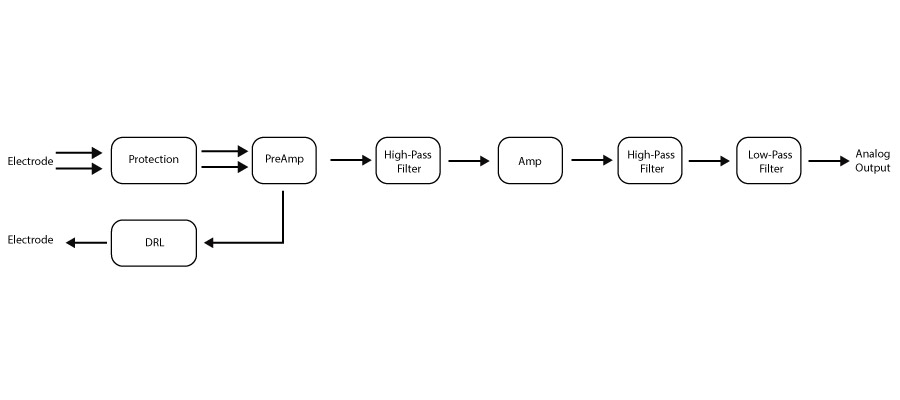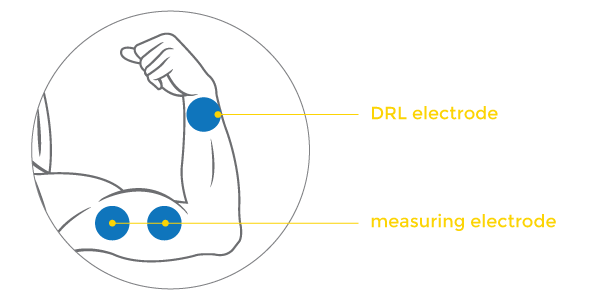EMG click measures the electrical activity produced by the skeletal muscles. It carries MCP609 operational amplifier and MAX6106 micropower voltage reference. EMG click is designed to run on a 5V power supply. The click board™ has an analog output (AN pin).

Note: EMG click is a prototyping tool, not a medical-grade device. Do not use it to diagnose patients.
What is EMG?
Electromyography or EMG is a diagnostic technique for measuring the electrical activity of muscles. It is often used to diagnose the health of these muscles, and the neurons that control them. These neurons are called motor neurons. They transmit electrical signals, and the muscles contract when this happens.
An EMG collects these signals and translates them into a graphical representation.

How EMG click works
The onboard 3.5mm audio jack is used to connect cables/electrodes to the click board. The electrode collects voltage from the skin (few millivolts). And the signal from the jack is amplified and filtered. Therefore, EMG click can be divided into seven blocks.

Setup guide
To record an EMG, you will need the following things:
- EMG click
- ECG/EMG cable
- Disposable adhesive pads (sold in packs of 30)
If you are starting out, the best offer is the EMG click bundle that contains all three.
Of course, you will also need a target board with an MCU with at least a 10-bit ADC (preferably powered from an external battery). Sampling rate should be at least 256Hz.
The electrodes are connected to the board with a cable that plugs into the onboard 3.5mm phone jack.

For optimal results place the first DRL electrode on the wrist of the hand. Place the second and third electrode on the muscle you want to measure. See the image above.
MikroPlot application
MikroPlot is a free data visualization tool (Windows) that can be used to generate an EMG graph. It’s a simple tool to help you visualize sensor data recorded over time.
The graph is generated from data sent from the microcontroller. A UART-USB connection is required.
MCP609 features
The MCP606/7/8/9 family of operational amplifiers (op amps) from Microchip Technology Inc. are unity-gain stable with low offset voltage (250 µV, maximum). Performance characteristics include rail-to-rail output swing capability and low input bias current (80 pA at +85°C, maximum).
MAX6106 features
The MAX6106 is a low-cost, low-dropout (LDO), micropower voltage reference. This three-terminal reference is available with output voltage options of 1.25V, 1.8V, 2.048V, 2.5V, 3V, 4.096V, 4.5V, and 5V. For this click, we used the 2.048V.
Key features
- MCP609 amplifier
- MAX6106 voltage reference
- 3.5mm audio jack
- Interface: AN pin
- 5V power supply

